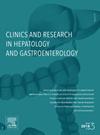吉西他滨-单抗-紫杉醇联合治疗局部晚期或转移性胰腺腺癌的相对剂量强度。
IF 2.4
4区 医学
Q2 GASTROENTEROLOGY & HEPATOLOGY
Clinics and research in hepatology and gastroenterology
Pub Date : 2025-03-28
DOI:10.1016/j.clinre.2025.102583
引用次数: 0
摘要
背景:吉西他滨-nab-紫杉醇(GNP)广泛用于治疗晚期或转移性胰腺腺癌(a/mPA),但在一线以外的相对剂量强度(RDI)方面尚无相关数据。目的:评估GNP的RDI作为a/mPA的二线或更大治疗(L2+)的影响。方法:回顾性分析接受L2+治疗的a/mPA患者。RDI分析从国民生产总值开始到第一次CT扫描。根据预定义阈值70%的RDI分析总生存期(OS)、无进展生存期(PFS)和毒性。结果:共纳入116例患者,中位RDI为70%(范围为20%-114%)。结论:我们的研究结果表明,GNP暴露水平在预定义的RDI阈值70%下,对我们的L2+治疗的a/mPA患者的生存没有显著影响。对于a/mPA接受L2+治疗的患者,可以评估其他GNP方案。本文章由计算机程序翻译,如有差异,请以英文原文为准。
Relative dose intensity of gemcitabine-nab-paclitaxel combination as second-line or more in locally advanced or metastatic pancreatic adenocarcinoma
Background
Gemcitabine-nab-paclitaxel (GNP) is widely used in treating advanced or metastatic pancreatic adenocarcinoma (a/mPA), but no data are available regarding its relative dose intensity (RDI) beyond the first line.
Aim
To assess the impact of the RDI of GNP as second-line or greater therapy (L2+) for a/mPA.
Methods
Patients with a/mPA undergoing L2+ treatment were retrospectively included. The RDI was analysed from the start of GNP to the first CT scan. Overall survival (OS), progression-free survival (PFS) and toxicity were analysed according to the RDI at a predefined threshold of 70 %.
Results
A total of 116 patients were included, with a median RDI of 70 % (range, 20 %-114 %). There was no significant difference in OS or PFS between RDI<70 % and ≥70 %, with median of 7.0 and 8.1 months (adjusted HR = 1.35; CI95 % [0.89–2.05]; p = 0.2) and 3.1 vs 3.4 months (adjusted HR = 1.36; CI95 % [0.91–2.05]; p = 0.14), respectively. Grade ≥3 toxicities were more common in RDI <70 % as compared to RDI ≥70 % (56.9 % vs. 37.9 %, p = 0.04) and responsible for more GNP dose reductions (67.7 % vs. 50 %, p = 0.13) and schedule modifications (72.4 % vs. 48.2 %, p = 0.008).
Conclusion
Our results suggest that the level of GNP exposure, at a predefined RDI threshold of 70 %, had no significant effect on survival in our patients treated in L2+ for a/mPA. Alternative GNP regimens may be evaluated in patients undergoing L2+ treatment for a/mPA.
求助全文
通过发布文献求助,成功后即可免费获取论文全文。
去求助
来源期刊

Clinics and research in hepatology and gastroenterology
GASTROENTEROLOGY & HEPATOLOGY-
CiteScore
4.30
自引率
3.70%
发文量
198
审稿时长
42 days
期刊介绍:
Clinics and Research in Hepatology and Gastroenterology publishes high-quality original research papers in the field of hepatology and gastroenterology. The editors put the accent on rapid communication of new research and clinical developments and so called "hot topic" issues. Following a clear Editorial line, besides original articles and case reports, each issue features editorials, commentaries and reviews. The journal encourages research and discussion between all those involved in the specialty on an international level. All articles are peer reviewed by international experts, the articles in press are online and indexed in the international databases (Current Contents, Pubmed, Scopus, Science Direct).
Clinics and Research in Hepatology and Gastroenterology is a subscription journal (with optional open access), which allows you to publish your research without any cost to you (unless you proactively chose the open access option). Your article will be available to all researchers around the globe whose institution has a subscription to the journal.
 求助内容:
求助内容: 应助结果提醒方式:
应助结果提醒方式:


